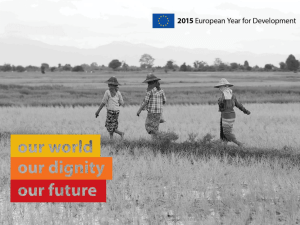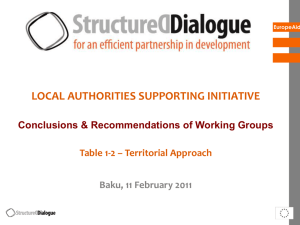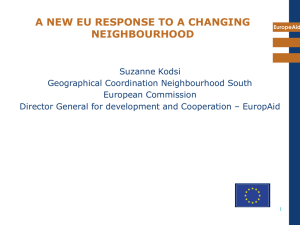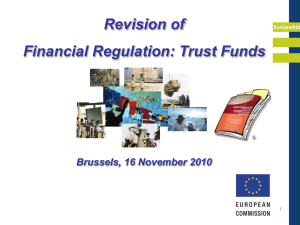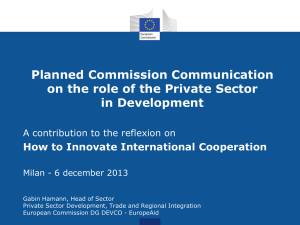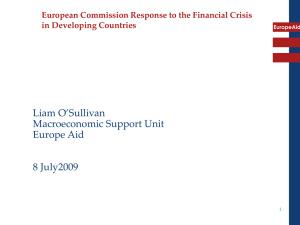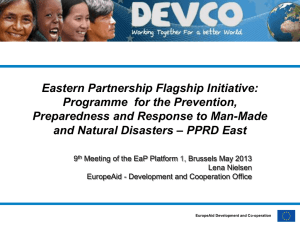Koos Richelle Director General of EuropeAid Washington, 16 May 2008
advertisement
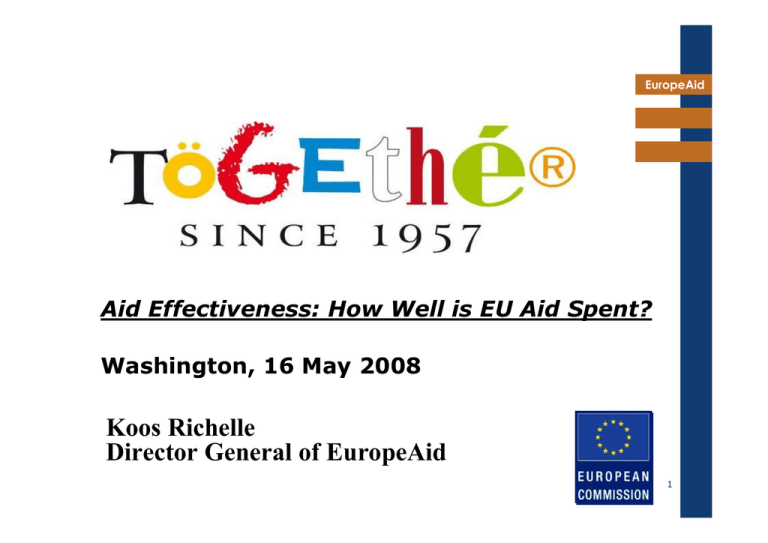
EuropeAid Aid Effectiveness: How Well is EU Aid Spent? Washington, 16 May 2008 Koos Richelle Director General of EuropeAid 1 Summary EuropeAid 1. European Commission aid over the years 2. Towards more effective aid 3. Towards faster, better, more aid: focus on results 2 1. European Commission aid over the years (1) EuropeAid Commitment, contracting and payment levels (?) € Million 2002 2003 2004 2005 2006 2007 Budget commitments EDF commitments Total commitments Budget contracts EDF contracts Total contracts Budget payments EDF payments Total payments 3.219 3.298 3.605 3.997 4.206 4.226 2.125 3.769 2.648 3.511 3.408 3.636 5.344 7.067 6.253 7.508 7.614 7.862 3.085 3.167 3.955 4.228 3.475 3.062 3.038 3.057 3.654 3.816 6.147 6.205 7.012 7.882 7.291 2.708 2.846 3.237 3.693 3.664 3.759 1.922 2.345 2.464 2.544 2.826 2.920 4.630 5.191 5.701 6.237 6.490 6.679 Budget Commitments 2007 • 4 3 EDF 2 Planned: €7.5 billion, we did €7.86 1 billion '02 '03 '04 '05 '06 30 '07 1. European Commission aid over the years (2) Development aid by sector EuropeAid Bilateral and Multilateral ODA flows 2001-2007 Commitments (M€) Sector of Destination 1 Social Infrastructures 2001 2002 2003 2004 2005 sub-total 2001-2007 2007 2006 1.850 2.053 2.871 3.293 3.832 3.933 4.263 43% 22.096 38% 2 Economic Infrastructures & Services 665 615 1.259 811 1.291 1.223 1.411 14% 7.274 13% 3 Production 861 925 558 445 455 806 718 7% 4.767 8% 1.188 719 669 925 512 1.086 873 9% 5.972 10% 567 1.272 1.134 890 1.275 698 988 10% 6.824 12% 76 89 574 5 0 0 23 0% 766 1% 609 613 636 684 1.386 1.403 1.064 11% 6.396 11% 178 246 568 487 536 684 608 6% 3.307 6% 5.994 6.533 8.269 7.538 9.287 9.832 9.947 100% 57.402 100% 4 Multisector/Crosscutting : Environment, Other 5 Budget Support, Food Aid, Food Security 6 Action relating to debt 7 Emergency assistance, Reconstruction Relief 9 Other/Unallocated GRAND TOTAL Around € 57.4 billion since 2001 4 1. European Commission aid over the years Late Nineties: exponential growth RAL (3) EuropeAid 1990: €7 billion, 2000: €19 billion 21 17 RAL 13 9 Commitments '90 '92 '94 '96 5 '98 1 '00 5 1. European Commission aid over the years From 2001 onwards: RAL under control (4) EuropeAid 2001: €19 billion, 2006: €21 billion 21 RAL 17 13 Commitments 9 5 '01 '02 '03 '04 '05 1 '06 6 1.European Commission aid over the years RAL in payment years (5) EuropeAid 2001: 4.71 years, 2006: 3.23 years 5 4 3 '01 '02 '03 '04 '05 2 '06 7 1. European Commission aid over the years EuropeAid (6) External aid budget 2007 External aid €10bn, 8% Non-EuropeAid budget €3.1 bn, 30% Community budget inside EU: €120bn, 92% EuropeAid EDF fund €3.5bn, 34% EuropeAid budget € 3.7bn, 36% Based on planned expenditures, including EDF. Non-EuropeAid budget includes pre-accession, humanitarian and emergency aid and Common Foreign & Security Policy. 8 1. European Union aid 2007 (7) EuropeAid EU largest donor in the world • 27 + 1 donors together responsible for 70 % of all development aid (EU27: €46.1 billions) • EU to increase its contribution by more than €25 billions by 2010 (MS responsible for 90% of increase) Commission on its own • Third largest donor after USA and Germany, followed by France, UK, Japan (OECD April 2008) • Second largest donor of humanitarian aid • Present in more than 150 countries 9 1. European Union aid: perspective (8) More money EuropeAid • EU aid effort in transitional decline (EU27: €46,1b estimated in 2007 versus €47,7b in 2006) • EU-15 to reach 0.70% ODA/GNI by 2015 (0.33% as individual target by 2006 and 0.51% by 2010) • EU to cannel 50% of collective aid increases to Africa • 8 Member states with a timetable that leads to achieving agreed ODA targets 10 ODA - % of GNI: situation 2006, forecast 2010, objective 2015 2015 2010 2006 1. European Union aid: perspective (9) 1 0.8 0.6 0.4 0.2 0 Source: European Commission, COM (2007) 164 of April 2007 (final draft) 11 EuropeAid Sweden L u x e m b u rg N e th e rla n d s D e n m a rk I re la n d UK B e lg iu m A u stria Fra n ce Fin la n d G e rm a n y S p a in P o rtu g a l Ita ly G re e c e M a lta C ze ch R e p S lo v e n ia H u n g a ry C y p ru s S lo v a k R e p P o la n d L ith u a n ia E sto n ia L a tv ia B u lg a ria R o m a n ia 2. Making aid more effective Highlights of the European Consensus (1) EuropeAid • Common development policy of 27 Member States and EC for the first time in fifty years of cooperation • Common principles for implementing development in the spirit of complementarity • Primary goal of poverty reduction and achieving MDGs together with objectives related to governance and human rights • But broader than MDGs: Links development with security, migration, trade, environment and social dimensions of globalisation • Promotes: supporting performance of developing countries; participation of civil society; commitment to fragile states and in-depth political dialogue 12 2. Making aid more effective Highlights of the European Consensus (2) EuropeAid • Themes: human rights; access to essential services; governance for development and security; environment and sustainable management of natural resources; economic growth and trade development; food security; and combating in-equalities • Operational principles of coordination, complementarity and division of labour • Increasing aid: target of 0.56% of GNI by 2010 and individual target of 0.51% (EU 15) and 0.17% (EU 12) • Increasing aid quality: innovative, flexible mechanisms • Strengthening aid-effectiveness and establishing work plan • Ensuring policy coherence for development. 13 2. Making aid more effective (3) EuropeAid Division of labour • Maximum of 3 sectors in each country (+GBS + support to civil society) • Redeploy funds in country based on local negotiation • In each sector, establish a lead donor for all coordination • In priority sectors relevant to poverty reduction, ensure adequate EU donor support • Limited number of priority countries • Address orphan gaps (often fragile states) • EU Donor Atlas: Mapping Official Development Assistance 14 2. Making aid more effective (4) EuropeAid Co-financing Both ways from EC to MS and vice versa More political than technical Agreement by partner country Not for small projects and should lead to combined efficiency gains • Follows EC ‘normal’ AAP procedure, and rules • Visibility and reciprocity • • • • 15 2. Making aid more effective (5) EuropeAid Joint programming • Joint analysis and multiannual planning moving forward since April 2006 • Limited use of EU Common Framework for Country Strategy Papers (CFCSP) – Somalia, Sierra Leone & South Africa • Discussion of Joint Programming: a good start of preparation for a division of labour (examples of Ghana & Mali) 16 2. Making aid more effective (6) EuropeAid MDG contract – better predictability • Targeted at strong performing countries • Six year duration, annual monitoring and medium - term performance assessment • Long-term predictability in return for greater commitments to results by partners 17 2. Making aid more effective (7) General & sector budget support – EuropeAid cumul. from 2002 4500 4000 3500 EUR millions 3000 2500 GBS SBS 2000 1500 1000 500 0 18 2002 2003 2004 2005 2006 2007 2. Making aid more effective (8) General & sector budget support EuropeAid (programmed for 2008-2013) Darker shades: more budget support (up to €125 million) 19 2. Making aid more effective (9) EuropeAid Paris Declaration • set of goals and 12 measurable indicators for donors and partner countries to increase aid effectiveness • 60 developing countries and 50 multilateral and bilateral donors signed up • The EC added 4 more commitments 20 2. Making aid more effective (10) EU Also Agreed More Ambitious Targets EuropeAid Provide all capacity building assistance through co-ordinated programmes with an increasing use of multidonor arrangements Channel 50% of government-to-government assistance through country systems, including by increasing the percentage of our assistance provided through budget support or sector-wide approaches Avoid the establishment of any new Project Implementation Units (PIUs) Reduce number of un-coordinated missions by 50% 21 21 2. Making aid more effective (11) Road to Accra EuropeAid • Accra will not revise the Paris Declaration but will table a small set of high impact actions by partner countries and donors, essential for meeting the Paris Targets • Expected to be turning point for less ‘donor driven agenda’ and increased partner country voice in aid effectiveness (South Africa playing lead role in DAC) • Also increased CSO involvement: left out of PD they will hold their own forum just prior to the HLF and bring out separate Accra document; thrust is ‘not aid effectiveness but development effectiveness’ 22 2. Making aid more effective (12) EuropeAid Donor coordination / three Cs debate • More coherence: development and other policies (trade, agricultural) should be in line with each other • More coordination: EU Member States and the Commission should work more closely together • More complementarity: less overlap between actions, better spread of work 23 2. Making aid more effective (13) Improving EU policy coherence EuropeAid • Outstanding issues to be followed up in 12 policy areas to ensure better coherence • New elements for exploring the development potential o from the biofuel market for fighting poverty o from challenges related to migration and brain drain o from research (collaboration on topics directly related to MDGs) 24 2. Making aid more effective (14) Aid for trade EuropeAid • EU pledge to commit €2 billion annually to trade related assistance by 2010: o €1b from MS + €1b from COM) • MS invited to increase efforts by almost 56% • Joint work in progress towards the development of regional ACP packages • Strong interest for regional funds noted 25 2. Making aid more effective (15) EuropeAid OECD/DAC more positive view of EC than in 2002: • Consensus is major strategic achievement (but raises issues on priorities, institutional challenges and oversight issues) • Aid effectiveness agenda: budget support, interest in governance • Administrative improvements, stronger financial management *Based on presentation by OECD/DAC Chair at EP, 10.09.07 26 2. Making aid more effective (16) EuropeAid OECD/DAC recommendations: • Focus resources on priority objectives • Focus on geographic use of ODA in context of EU division of labour • Focus on more explicit frameworks with multilaterals, including clearer role in relation to member states • Work on greater field authority on project approval, results reporting, delegated cooperation *Based on presentation by OECD/DAC Chair at EP, 10.09.07 27 3. Towards faster, better, more aid: focus on results (1) We Need to Do A lot More…. EuropeAid • No of donors present: 9 Countries with 40+ official donors ballooned from zero in 1990 to over 30 today 9 In Vietnam 11 UN agencies account for only 2% of aid 9 20 UN agencies active in Island of Zanzibar alone • Size of programmes: 9 average size of aid programmes dropped from $2.5 million in 1997 to $1.5 million in 2004 • Number of programmes: 9 Total number of activities surged from 20,000 in 1997 to 60,000 in 2004 • Missions: 9 Paris baseline survey: “the total number of missions is strikingly high for some countries and some donors” 28 3. Towards faster, better, more aid: focus on results (2) But We Need to Do A lot More…. EuropeAid Aid effectiveness • We all need to become ‘aid effective’ • Driving Division of Labour forward • Putting co-financing into practice • Progress needed for High Level Forum Accra Meeting Paris and EU targets • Technical cooperation better aligned • Fewer parallel PIUs • More use of country systems • More programme-based approaches • More joint missions 29 3. Towards faster, better, more aid: focus on results (3) EuropeAid • MDGs prove to be a powerful incentive for result orientation. • If donors and recipients are not able to show progress and results the MDGs could become a Trojan Horse. • No donor in the whole world can provide in an easy and comprehensible way reliable information on output of its activities, let alone on outcome and impact over the years. • Donorland is characterized by an unsustainable analog arrogance in a digital era. • Results are imperative for keeping the momentum for 30 increased aid.
